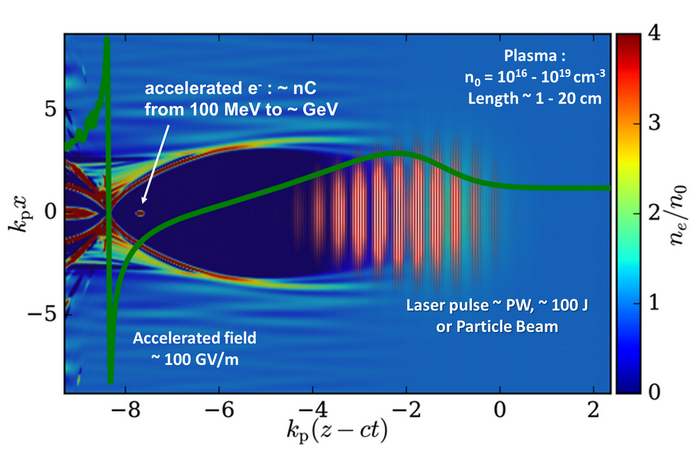The EUPRAXIA project has just completed its design study phase with the delivery of the Conceptual Design Report (CDR) at the end of 2019. The strong involvement of IRFU, particularly in the field of particle beam physics, has made it possible to show that solutions exist for the realization of a plasma wakefield accelerator, with a beam quality approaching that of conventional accelerators.
Detailed studies of the physical mechanisms involved have efficiently guided the numerical simulations, each lasting more than 10 hours on 2048 computing nodes, to demonstrate that all the objectives on the output beam can be achieved with a plasma of 30 cm long, 1.1017 cm-3 electronic density and a laser of 400 terawatts power, 50 joules energy. Innovative methods have been developed for accelerating and driving the beam through the two plasma stages to the end user without degrading the beam. A first analysis of error tolerances allowed to identify the most sensitive components to which particular care should be taken during the fabrication and implementation.
The EuPRAXIA collaboration
EuPRAXIA (European Plasma Research Accelerator with eXcellence In Applications) is a consortium including 16 participating members, European institutes or universities, and 25 associated partners from Europe, America and Asia, as well as 5 private companies from the power laser industry. Its objective is to study and then build an accelerator based on plasma acceleration techniques, capable of providing on-site user communities with an electron beam at an energy of 1 to 5 GeV, a charge of 30 pC, an emittance and energy dispersion smaller than 1mm.mrad and 1%, at a rate of 10-100 Hz, with reproducibility and reliability at "industrial" quality. With these characteristics combined simultaneously, this project aims at a major breakthrough, both scientific and technical, bringing wakefield acceleration as a physics experiment toward particle accelerators as a facility delivering beams to users.
Wakefield acceleration
As it passes through a plasma column, a power laser or a particle beam leaves a millimeter-sized cavity in its wake, with an excess of electrons behind and on the sides of this cavity. This is the mechanism of the ponderomotive force. A bucket of electrons injected into this part of the cavity can be strongly accelerated and focused by the resulting Coulomb forces. Typically, a laser of 1 petawatt and a plasma of density 1016-1019 cm-3 can generate an accelerating field up to 100 GV/m, which is 1000 times higher than the fields produced by conventional radio frequency techniques. Potentially, this will reduce the size of the accelerators by several orders of magnitude.

Wakefield acceleration in a plasma. The propagation of the laser pulse (set of red vertical lines) in the plasma (light blue background) leaves in its wake a cavity (blue-black) where electrons are expelled in the back and on the sides (dark red), generating an accelerating field due to the Coulomb force (green line). Electrons (dark red dot) injected into this rear part will be strongly accelerated and focused. Image calculated in the reference frame linked to the laser pulse, in reduced coordinates (kp is the plasma wavelength).
Towards a high energy, high charge, high beam quality plasma accelerator
This design phase involves a series of major challenges to be met because obtaining a high energy, high charge and high beam quality beam simultaneously has never been demonstrated, either experimentally or theoretically. The IRFU's contribution on these aspects has been decisive, through its responsibility, co-responsibility or participation in the "WP2-Physics and simulations", "WP5-Design and optimization of beam transport lines" and "WP15-Diagnostics" work packages.
IRFU's efforts were focused on two-stage laser-plasma accelerator configurations, a first stage for optimizing electron injection and acceleration up to 150 MeV and a second stage for acceleration up to the final energy of 5 GeV. Detailed studies have been undertaken on the physical mechanisms acting on the profiles of the accelerating and focusing wakefields. This allowed to guide the fine optimizations carried out by numerical simulations, each lasting more than 10 hours on 2048 computing nodes. It was thus possible to demonstrate that all the objectives on the output beam can be achieved with a plasma of 30 cm long, 1.1017 cm-3 electronic density and a laser of 400 terawatt power, 50 joules energy, with well-defined characteristics.
Thanks to a dual expertise in laser-plasma acceleration and conventional radio-frequency acceleration, innovative methods have been implemented to be able, without degrading the beam, to extract it from a plasma stage, transport it and inject it into a second stage, or transport it to the end user. Finally, an analysis of error tolerances allowed to identify the most sensitive components to which particular care should be taken during fabrication and implementation.
Close collaboration with EuPRAXIA's European partners led to the determination and optimization of several other injections and extraction schemes capable of achieving the desired objectives. In a subsequent step, a performance/risk analysis will be undertaken in order to select the best acceleration configuration as well as the laser and plasma systems. This will be followed by more detailed engineering studies to really get the manufacturing and installation phase underway.
The completion of this first design study phase marks a decisive step towards a true accelerator based on plasma acceleration techniques.
Contacts: P. A. P. Nghiem, A. Chancé
Publications:
- X. Li, P. A. P. Nghiem, and A. Mosnier, Toward low energy spread in plasma accelerators in quasilinear regime, Phys. Rev. Accel. Beams 21, 111301 (2018).
- X. Li, A. Chancé, and P. A. P. Nghiem, Preserving emittance by matching out and matching in plasma wakefield acceleration stage, Phys. Rev. Accel. Beams 22, 021304 (2019).
- P. A. P. Nghiem et al., Toward a plasma-based accelerator at high beam energy with high beam charge and high beam quality, Phys. Rev. Accel. Beams 23, 031301 (2020).
• Accelerator physics and technology › R&D and Instrumentation for Future Accelerators
• Accelerators, Cryogenics and Magnetism Division (DACM)
• LEDA




